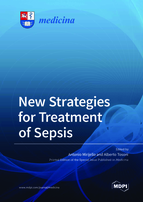New Strategies for Treatment of Sepsis
A special issue of Medicina (ISSN 1648-9144). This special issue belongs to the section "Emergency Medicine".
Deadline for manuscript submissions: closed (30 June 2021) | Viewed by 42268
Special Issue Editors
Interests: sepsis; internal medicine; addiction medicine; alcohol use disorders; alcoholic cardiomyopathy
Special Issues, Collections and Topics in MDPI journals
Interests: sepsis; internal medicine; addiction medicine; gastroenterology
Special Issues, Collections and Topics in MDPI journals
Special Issue Information
Dear Colleagues,
Sepsis represents an emerging and one of the deadliest diseases worldwide, accounting for millions of preventable deaths every year, being the cause, directly or indirectly, of about half of all hospital deaths.
Until a decade ago, sepsis was managed almost exclusively by intensivists. Consequently most of the literature on this topic derives from studies conducted in Intensive Care Units (ICUs). However, in recent years, there has been a progressive increase in admissions of septic patients to non-ICU wards. The characteristics of septic population have gradually changed—being constantly older, more co-morbid and chronic—as well as the early management of sepsis and septic shock. As a consequence, there is the need for literature data derived both from intensive and non-intensive departments, in order to fill the gap of knowledge and for confirmatory purposes.
Being a time-dependent disease, sepsis requires a prompt recognition and a standardized approach for optimal treatment. In general medicine wards, the main limitations to this purpose are represented by the unfavorable proportion between patients and staff and by the lack of constant monitoring of vital functions.
We are still far from a full knowledge of the mechanisms underlying the development and progression of sepsis. It is in this context that, in the last few years, new scenarios have been opening for sepsis management, including the use of new diagnostic tools with less invasive approaches, the growing role of artificial intelligence, the development of better antibiotic therapy strategies and the optimization of involved health resourses.
This Special Issue has been brought about to disseminate the knowledge of a new blueprint for the treatment of sepsis, particularly among non-intensivists physicians.
Dr. Antonio Mirijello
Dr. Alberto Tosoni
Guest Editors
Manuscript Submission Information
Manuscripts should be submitted online at www.mdpi.com by registering and logging in to this website. Once you are registered, click here to go to the submission form. Manuscripts can be submitted until the deadline. All submissions that pass pre-check are peer-reviewed. Accepted papers will be published continuously in the journal (as soon as accepted) and will be listed together on the special issue website. Research articles, review articles as well as short communications are invited. For planned papers, a title and short abstract (about 100 words) can be sent to the Editorial Office for announcement on this website.
Submitted manuscripts should not have been published previously, nor be under consideration for publication elsewhere (except conference proceedings papers). All manuscripts are thoroughly refereed through a single-blind peer-review process. A guide for authors and other relevant information for submission of manuscripts is available on the Instructions for Authors page. Medicina is an international peer-reviewed open access monthly journal published by MDPI.
Please visit the Instructions for Authors page before submitting a manuscript. The Article Processing Charge (APC) for publication in this open access journal is 1800 CHF (Swiss Francs). Submitted papers should be well formatted and use good English. Authors may use MDPI's English editing service prior to publication or during author revisions.
Keywords
- sepsis
- septic shock
- intensive care unit
- internal medicine
- non-intensive cares
- prognostication
- antibiotic treatment
- artificial intelligence
- immune response
- non-invasive monitoring








